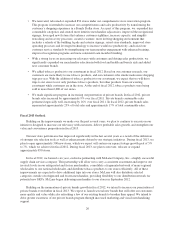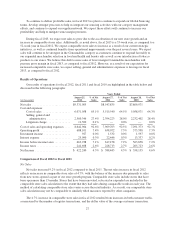Family Dollar 2012 Annual Report Download - page 21
Download and view the complete annual report
Please find page 21 of the 2012 Family Dollar annual report below. You can navigate through the pages in the report by either clicking on the pages listed below, or by using the keyword search tool below to find specific information within the annual report.We are exposed to the risk of natural disasters, unusual weather, pandemic outbreaks, global political events,
war, and terrorism that could disrupt business and result in lower sales, increased operating costs and capital
expenditures.
Our Store Support Center, store locations and distribution centers, as well as certain of our vendors and
customers, are located in areas which could be subject to natural disasters such as floods, hurricanes, tornadoes or
earthquakes. Adverse weather conditions or other extreme changes in the weather, including resulting electrical
and technological failures, may disrupt our business and may adversely affect our ability to sell and distribute
products. In addition, we operate in markets that may be susceptible to pandemic outbreaks, war, terrorist acts or
disruptive global political events, such as civil unrest in countries from which our suppliers are located. Our
business may be harmed if our ability to sell and distribute products is impacted by any such events, any of
which could influence customer trends and purchases and may negatively impact our net sales, properties or
operations. Such events could result in physical damage to one or more of our properties, the temporary closure
of some or all of our stores or distribution centers, the temporary lack of an adequate work force in a market,
temporary or long-term disruption in the transport of goods, delay in the delivery of goods to our distribution
centers or stores, disruption of our technology support or information systems, or fuel shortages or dramatic
increases in fuel prices, which increase the cost of doing business. Any of these factors, or combination thereof,
could adversely affect our operations.
Our current insurance program may expose us to unexpected costs and negatively affect our financial
performance.
We use a combination of insurance and self-insurance to provide for potential liability for workers’
compensation, automobile and general liability, property, director and officers’ liability, and employee health
care benefits. Any actuarial projection of losses is subject to a high degree of variability. Changes in legal claims,
trends and interpretations, variability in inflation rates, changes in the nature and method of claims settlement,
benefit level changes due to changes in applicable laws, insolvency of insurance carriers, and changes in discount
rates could all adversely affect our financial condition, results of operations, or cash flows.
Failure to comply with our debt covenants could adversely affect our capital resources, financial condition and
liquidity.
Our debt agreements contain certain restrictive covenants, which impose various operating and financial
restrictions on us. Such restrictions include, but are not limited to, a consolidated debt to consolidated
capitalization ratio, a fixed charge coverage ratio, and a priority debt ratio. Our failure to comply with the
restrictive covenants in our debt agreements, as a result of one or more of the factors listed in this section,
could result in an event of default, which, if not cured or waived, could result in us having to repay our
borrowings before their due dates. If we are forced to refinance these borrowings on less favorable terms, our
results of operations or financial condition could be harmed. In addition, if we are in default under any of our
existing or future debt facilities, we will be unable to borrow additional amounts under those facilities to the
extent that they would otherwise be available. Our ability to obtain future financing may also be impacted
negatively.
Our ability to obtain additional financing on favorable terms, if needed, could be adversely affected by volatility
in the capital markets.
We obtain and manage liquidity from the positive cash flow we generate from our operating activities and
our access to capital markets, including our credit facilities with a consortium of banks. There is no assurance
that our ability to obtain additional financing through the capital markets, if needed, will not be adversely
impacted by economic conditions. Tightening in the credit markets, low liquidity and volatility in the capital
markets could result in diminished availability of credit, higher cost of borrowing and lack of confidence in the
equity market, making it more difficult to obtain additional financing on terms that are favorable to us.
17
























